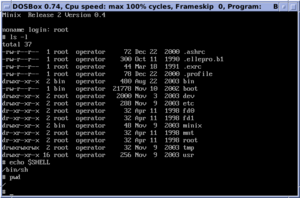Minix facts for kids
 |
|

The MINIX 3.3.0 login prompt
|
|
| Company / developer | Andrew S. Tanenbaum, et al. |
|---|---|
| Programmed in | C |
| OS family | Unix-like |
| Working state | Abandoned |
| Source model | Open-source |
| Initial release | 1987 |
| Latest stable release | 3.3.0 / 16 September 2014 |
| Latest unstable release | 3.4.0rc6 / 9 May 2017 |
| Marketing target | Teaching (v1, v2) Embedded systems (v3) |
| Available language(s) | English |
| Package manager | N/A |
| Supported platforms | IBM PC compatibles, 68000, SPARC, Atari ST, Amiga, Macintosh, SPARCstation, Intel 386, NS32532, ARM, Inmos transputer, Intel Management Engine |
| Kernel type | Microkernel |
| Userland | BSD (NetBSD) |
| License | 2005: BSD 3-Clause 2000: BSD 3-Clause 1995: Proprietary 1987: Proprietary |
MINIX is a special kind of operating system that works like Unix. It was first created in 1987 by a computer scientist named Andrew S. Tanenbaum. He designed MINIX to be a smaller, simpler version of Unix. It could run on home computers that weren't too expensive. MINIX was mostly used to teach computer science students at universities.
The name MINIX comes from "mini-Unix" because it was a small version. At first, you had to pay a small fee to use its code. But in 2000, it became free and open-source. This meant anyone could use and change it. MINIX was updated over the years. Starting with MINIX 3 in 2005, it became more focused on being a very reliable and "self-healing" system. This means it could fix itself if something went wrong.
Contents
How MINIX Was Made
MINIX 1.0: The Beginning
Andrew S. Tanenbaum created MINIX at a university in Amsterdam. He made it to show the ideas from his textbook, Operating Systems: Design and Implementation. The book even included a short version of MINIX's code. This code showed how the main parts of the system worked.
MINIX 1.0 was made to work with the IBM PC computers that were popular back then.
MINIX 1.5: More Computers Supported
MINIX 1.5 came out in 1991. This version could run on more types of computers. It worked on systems like the Atari ST, Amiga, and Macintosh. There were also unofficial versions made for other processors.
MINIX 2.0: New Features and Updates
MINIX 2.0 was released in 1997. It was included with the second edition of Tanenbaum's textbook. This version added important features. It could now work with POSIX standards, which are rules for how operating systems should behave. It also got better internet features.
In 2001, MINIX 2.0.3 was released. This was the first version after MINIX became free and open-source.
Minix-vmd: Adding Virtual Memory
Minix-vmd was a special version of MINIX 2.0. It was made by researchers to add virtual memory. This feature helps computers run more programs at once. It also allowed MINIX to support the X Window System, which helps create graphical interfaces.
MINIX 3: Focus on Reliability
MINIX 3 was announced in 2005. While it still helped teach students, its main goal changed. It aimed to be a very reliable system for small, special computers. These are often called Embedded systems. It was designed to be "self-healing," meaning it could fix problems without stopping.
MINIX 3 can run on different computer systems. You can even try it out using a live CD. This lets you use MINIX without installing it on your computer's hard drive. It also works with programs that pretend to be computers, like VirtualBox.
Version 3.1.5 came out in 2009. This version added many common Unix tools. It also included X11, which allowed MINIX to have a graphical interface. This was a big step from being a text-only system.
MINIX 3.1.5 could automatically restart crashed parts of the system. This made it very reliable. It also gained virtual memory support. This made it more suitable for regular desktop use.
With version 3.2.0, released in 2012, MINIX started using parts from NetBSD. This allowed it to use many more software applications.
MINIX 3.3.0, released in September 2014, added support for ARM processors.
The development of MINIX has slowed down since 2018. A stable version of MINIX 3.4.0 has not been released.
MINIX supports many computer languages. These include C, Python, and Perl.
It's interesting to know that all Intel computer chips made after 2015 use MINIX 3. It runs inside them as part of the Intel Management Engine.
MINIX and Linux
Early Influence
Linus Torvalds, who created Linux, used MINIX when he was first developing Linux. He liked MINIX, but he decided to build Linux differently. This led to a famous discussion between Tanenbaum and Torvalds.
Early versions of the Linux kernel were even created on a MINIX system. Linux also borrowed some ideas from MINIX, like its MINIX file system. Over time, the MINIX code was completely replaced in Linux.
How MINIX Changed Its License
When MINIX was first made, its license was quite open. It had a small fee, which was much less than other operating systems. Tanenbaum wanted students to be able to use MINIX easily. But his publisher wanted to make sure the code wasn't copied freely. So, a small fee was included with Tanenbaum's book. This meant MINIX couldn't be given away for free.
In the early 1990s, other free operating systems like Linux became available. Many volunteer programmers started working on these instead of MINIX. In April 2000, MINIX became free and open-source software. This meant anyone could use and share it without paying. However, by then, other operating systems had become more advanced. MINIX mostly remained a system for students and people who enjoyed exploring.
See also
 In Spanish: MINIX para niños
In Spanish: MINIX para niños
- MINIX file system
- Redox, another operating system
- Xinu
- xv6






